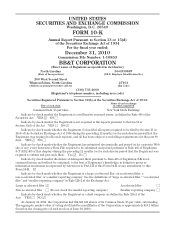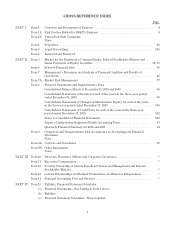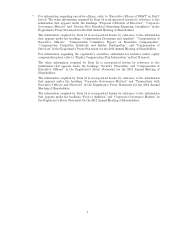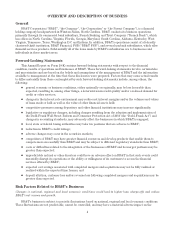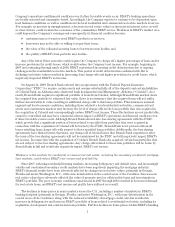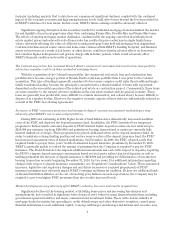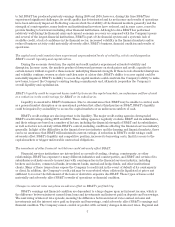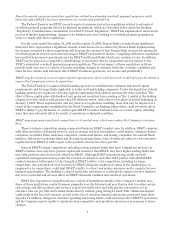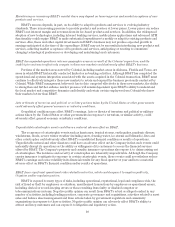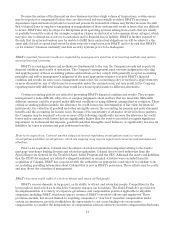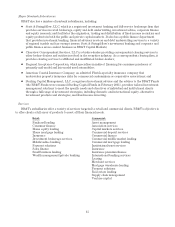BB&T 2010 Annual Report Download - page 5
Download and view the complete annual report
Please find page 5 of the 2010 BB&T annual report below. You can navigate through the pages in the report by either clicking on the pages listed below, or by using the keyword search tool below to find specific information within the annual report.Company’s operations and financial condition even if other favorable events occur. BB&T’s banking operations
are locally oriented and community-based. Accordingly, the Company expects to continue to be dependent upon
local business conditions as well as conditions in the local residential and commercial real estate markets it serves.
For example, an increase in unemployment, a decrease in real estate values or increases in interest rates, as well
as other factors, could weaken the economies of the communities BB&T serves. Weakness in BB&T’s market area
could depress the Company’s earnings and consequently its financial condition because:
Šcustomers may not want or need BB&T’s products or services;
Šborrowers may not be able or willing to repay their loans;
Šthe value of the collateral securing loans to borrowers may decline; and
Šthe quality of BB&T’s loan portfolio may decline.
Any of the latter three scenarios could require the Company to charge off a higher percentage of loans and/or
increase provisions for credit losses, which would reduce the Company’s net income. For example, beginning in
2007 and continuing through much of 2010, BB&T experienced increasing credit deterioration due to ongoing
challenges in the residential real estate markets. This period of credit deterioration combined with flat to
declining real estate values resulted in increasing loan charge-offs and higher provisions for credit losses, which
negatively impacted BB&T’s net income.
On August 14, 2009, Branch Bank entered into an agreement with the Federal Deposit Insurance
Corporation (“FDIC”) to acquire certain assets and assume substantially all of the deposits and certain liabilities
of Colonial Bank, an Alabama state-chartered bank headquartered in Montgomery, Alabama (“Colonial”). As a
result, Branch Bank acquired a significant portfolio of loans from Colonial. Although Branch Bank marked down
the acquired loan portfolio to estimated fair value, there is no assurance that the acquired loans will not suffer
further deterioration in value resulting in additional charge-offs to this loan portfolio. Fluctuations in national,
regional and local economic conditions, including those related to local residential real estate, commercial real
estate and construction markets may increase the level of charge-offs on the loan portfolio that was acquired in
the acquisition of Colonial and correspondingly reduce BB&T’s net income. These fluctuations are not predictable,
cannot be controlled and may have a material adverse impact on BB&T’s operations and financial condition even
if other favorable events occur. Although Branch Bank entered into loss sharing agreements with the FDIC,
which provide that a significant portion of losses related to specified loan portfolios that were acquired in
connection with the acquisition of Colonial will be borne by the FDIC, Branch Bank is not protected from all
losses resulting from charge-offs with respect to those specified loan portfolios. Additionally, the loss sharing
agreements have limited terms; therefore, any charge-off of related losses that Branch Bank experiences after
the term of the loss sharing agreements will not be reimbursed by the FDIC and will negatively impact BB&T’s
net income. In connection with the acquisition of Colonial, Branch Bank also acquired certain loan portfolios that
are not subject to the loss sharing agreements. Any charge-offs related to these loan portfolios will be borne by
Branch Bank in full and would also negatively impact BB&T’s net income.
Weakness in the markets for residential or commercial real estate, including the secondary residential mortgage
loan markets, could reduce BB&T’s net income and profitability.
Since 2007, softening residential housing markets, increasing delinquency and default rates, and increasingly
volatile and constrained secondary credit markets have been negatively impacting the mortgage industry.
BB&T’s financial results have been adversely affected by changes in real estate values, primarily in Georgia,
Florida and metro Washington, D.C., with some deterioration in the coastal areas of the Carolinas. Decreases in
real estate values have adversely affected the value of property used as collateral for loans and investments in
BB&T’s portfolio. The poor economic conditions experienced in 2007 through 2010 resulted in decreased demand
for real estate loans, and BB&T’s net income and profits have suffered as a result.
The declines in home prices in many markets across the U.S., including a number of markets in BB&T’s
banking footprint (primarily in Georgia, Florida, and metro Washington, D.C., with some deterioration in the
coastal areas of the Carolinas), along with the reduced availability of mortgage credit, also has resulted in
increases in delinquencies and losses in BB&T’s portfolio of loans related to residential real estate, including its
acquisition, development and construction loan portfolio. Further declines in home prices within BB&T’s banking
5

